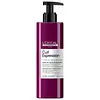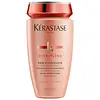L'Oréal Professionnel Curl Expression Defining Leave-In Jelly Versus Kérastase Discipline Bain Fluidealiste Shampoo
What's inside
What's inside
 Key Ingredients
Key Ingredients

No key ingredients
 Benefits
Benefits

 Concerns
Concerns

 Ingredients Side-by-side
Ingredients Side-by-side

Water
Skin ConditioningCetearyl Alcohol
EmollientGlycerin
HumectantIsopropyl Myristate
EmollientHydroxypropyl Guar
Emulsion StabilisingBis-Diglyceryl Polyacyladipate-2
EmollientCetearyl Glucoside
EmulsifyingSodium Benzoate
MaskingCocos Nucifera Oil
MaskingCaprylyl Glycol
EmollientButyrospermum Parkii Butter
Skin ConditioningSclerotium Gum
Emulsion StabilisingCitric Acid
BufferingHydroxyethyl Urea
HumectantLimonene
PerfumingBenzyl Salicylate
PerfumingBenzyl Alcohol
PerfumingHibiscus Esculentus Seed Extract
Skin ConditioningPhenoxyethanol
PreservativeParfum
MaskingWater, Cetearyl Alcohol, Glycerin, Isopropyl Myristate, Hydroxypropyl Guar, Bis-Diglyceryl Polyacyladipate-2, Cetearyl Glucoside, Sodium Benzoate, Cocos Nucifera Oil, Caprylyl Glycol, Butyrospermum Parkii Butter, Sclerotium Gum, Citric Acid, Hydroxyethyl Urea, Limonene, Benzyl Salicylate, Benzyl Alcohol, Hibiscus Esculentus Seed Extract, Phenoxyethanol, Parfum
Water
Skin ConditioningSodium Cocoyl Isethionate
CleansingSodium Lauryl Sulfoacetate
CleansingDisodium Laureth Sulfosuccinate
CleansingSodium Lauroyl Sarcosinate
CleansingGlycol Distearate
EmollientCocamidopropyl Betaine
CleansingGlycereth-26
HumectantDecyl Glucoside
CleansingHydrogenated Coconut Acid
EmollientCoco-Betaine
CleansingPPG-5-Ceteth-20
EmulsifyingSodium Benzoate
MaskingDivinyldimethicone/Dimethicone Copolymer
Sodium Chloride
MaskingPolyquaternium-7
Amodimethicone
Polyquaternium-10
Sodium Isethionate
CleansingSalicylic Acid
MaskingPEG-55 Propylene Glycol Oleate
Propylene Glycol
HumectantCarbomer
Emulsion StabilisingC11-15 Pareth-7
EmulsifyingBenzoic Acid
MaskingArginine
MaskingGlutamic Acid
HumectantBenzyl Salicylate
PerfumingLaureth-9
EmulsifyingBenzyl Alcohol
PerfumingGlycerin
HumectantSerine
MaskingHydroxypropyltrimonium Hydrolyzed Wheat Protein
Skin ConditioningTrideceth-12
EmulsifyingC12-13 Pareth-23
Cleansing2-Oleamido-1,3-Octadecanediol
Skin ConditioningLinalool
PerfumingAlpha-Isomethyl Ionone
PerfumingC12-13 Pareth-3
EmulsifyingSodium Hydroxide
BufferingCitric Acid
BufferingParfum
MaskingWater, Sodium Cocoyl Isethionate, Sodium Lauryl Sulfoacetate, Disodium Laureth Sulfosuccinate, Sodium Lauroyl Sarcosinate, Glycol Distearate, Cocamidopropyl Betaine, Glycereth-26, Decyl Glucoside, Hydrogenated Coconut Acid, Coco-Betaine, PPG-5-Ceteth-20, Sodium Benzoate, Divinyldimethicone/Dimethicone Copolymer, Sodium Chloride, Polyquaternium-7, Amodimethicone, Polyquaternium-10, Sodium Isethionate, Salicylic Acid, PEG-55 Propylene Glycol Oleate, Propylene Glycol, Carbomer, C11-15 Pareth-7, Benzoic Acid, Arginine, Glutamic Acid, Benzyl Salicylate, Laureth-9, Benzyl Alcohol, Glycerin, Serine, Hydroxypropyltrimonium Hydrolyzed Wheat Protein, Trideceth-12, C12-13 Pareth-23, 2-Oleamido-1,3-Octadecanediol, Linalool, Alpha-Isomethyl Ionone, C12-13 Pareth-3, Sodium Hydroxide, Citric Acid, Parfum
Ingredients Explained
These ingredients are found in both products.
Ingredients higher up in an ingredient list are typically present in a larger amount.
Benzyl Alcohol is most commonly used as a preservative. It also has a subtle, sweet smell. Small amounts of Benzyl Alcohol is not irritating and safe to use in skincare products. Most Benzyl Alcohol is derived from fruits such as apricots.
Benzyl Alcohol has both antibacterial and antioxidant properties. These properties help lengthen the shelf life of products. Benzyl Alcohol is a solvent and helps dissolve other ingredients. It can also improve the texture and spreadability.
Alcohol comes in many different forms. Different types of alcohol will have different effects on skin. This ingredient is an astringent alcohol.
Using high concentrations of these alcohols are drying on the skin. They may strip away your skin's natural oils and even damage your skin barrier. Astringent alcohols may also irritate skin.
Other types of astringent alcohols include:
According to the National Rosacea Society based in the US, you should be mindful of products with these alcohols in the top half of ingredients.
Any type of sanitizing product will have high amounts of alcohol to help kill bacteria and viruses.
Learn more about Benzyl AlcoholBenzyl Salicylate is a solvent and fragrance additive. It is an ester of benzyl alcohol and salicylic acid. This ingredient can be naturally found in some plants and plant extracts.
In fragrances, Benzyl Salicylate may be a solvent or a fragrance component. In synthetic musk scents, it is used as a solvent. For floral fragrances such as lilac and jasmine, it is used as a fragrance component. The natural scent of Benzyl Salicylate is described as "lightly-sweet, slightly balsamic".
While Benzyl Salicylate has been associated with contact dermatitis and allergies, emerging studies show it may not be caused by this ingredient alone.
However, this ingredient is often used with fragrances and other components that may cause allergies. It is still listed as a known allergen in the EU. We recommend speaking with a professional if you have concerns.
Another study from 2021 shows Benzyl Salicylate may have anti-inflammatory properties.
Learn more about Benzyl SalicylateCitric Acid is an alpha hydroxy acid (AHA) naturally found in citrus fruits like oranges, lemons, and limes.
Like other AHAs, citric acid can exfoliate skin by breaking down the bonds that hold dead skin cells together. This helps reveal smoother and brighter skin underneath.
However, this exfoliating effect only happens at high concentrations (20%) which can be hard to find in cosmetic products.
Due to this, citric acid is usually included in small amounts as a pH adjuster. This helps keep products slightly more acidic and compatible with skin's natural pH.
In skincare formulas, citric acid can:
While it can provide some skin benefits, research shows lactic acid and glycolic acid are generally more effective and less irritating exfoliants.
Most citric acid used in skincare today is made by fermenting sugars (usually from molasses). This synthetic version is identical to the natural citrus form but easier to stabilize and use in formulations.
Read more about some other popular AHA's here:
Learn more about Citric AcidGlycerin is already naturally found in your skin. It helps moisturize and protect your skin.
A study from 2016 found glycerin to be more effective as a humectant than AHAs and hyaluronic acid.
As a humectant, it helps the skin stay hydrated by pulling moisture to your skin. The low molecular weight of glycerin allows it to pull moisture into the deeper layers of your skin.
Hydrated skin improves your skin barrier; Your skin barrier helps protect against irritants and bacteria.
Glycerin has also been found to have antimicrobial and antiviral properties. Due to these properties, glycerin is often used in wound and burn treatments.
In cosmetics, glycerin is usually derived from plants such as soybean or palm. However, it can also be sourced from animals, such as tallow or animal fat.
This ingredient is organic, colorless, odorless, and non-toxic.
Glycerin is the name for this ingredient in American English. British English uses Glycerol/Glycerine.
Learn more about GlycerinParfum is a catch-all term for an ingredient or more that is used to give a scent to products.
Also called "fragrance", this ingredient can be a blend of hundreds of chemicals or plant oils. This means every product with "fragrance" or "parfum" in the ingredients list is a different mixture.
For instance, Habanolide is a proprietary trade name for a specific aroma chemical. When used as a fragrance ingredient in cosmetics, most aroma chemicals fall under the broad labeling category of “FRAGRANCE” or “PARFUM” according to EU and US regulations.
The term 'parfum' or 'fragrance' is not regulated in many countries. In many cases, it is up to the brand to define this term.
For instance, many brands choose to label themselves as "fragrance-free" because they are not using synthetic fragrances. However, their products may still contain ingredients such as essential oils that are considered a fragrance by INCI standards.
One example is Calendula flower extract. Calendula is an essential oil that still imparts a scent or 'fragrance'.
Depending on the blend, the ingredients in the mixture can cause allergies and sensitivities on the skin. Some ingredients that are known EU allergens include linalool and citronellol.
Parfum can also be used to mask or cover an unpleasant scent.
The bottom line is: not all fragrances/parfum/ingredients are created equally. If you are worried about fragrances, we recommend taking a closer look at an ingredient. And of course, we always recommend speaking with a professional.
Learn more about ParfumSodium Benzoate is a preservative. It's used in both cosmetic and food products to inhibit the growth of mold and bacteria. It is typically produced synthetically.
Both the US FDA and EU Health Committee have approved the use of sodium benzoate. In the US, levels of 0.1% (of the total product) are allowed.
Sodium benzoate works as a preservative by inhibiting the growth of bacteria inside of cells. It prevents the cell from fermenting a type of sugar using an enzyme called phosphofructokinase.
It is the salt of benzoic acid. Foods containing sodium benzoate include soda, salad dressings, condiments, fruit juices, wines, and snack foods.
Studies for using ascorbic acid and sodium benzoate in cosmetics are lacking, especially in skincare routines with multiple steps.
We always recommend speaking with a professional, such as a dermatologist, if you have any concerns.
Learn more about Sodium BenzoateWater. It's the most common cosmetic ingredient of all. You'll usually see it at the top of ingredient lists, meaning that it makes up the largest part of the product.
So why is it so popular? Water most often acts as a solvent - this means that it helps dissolve other ingredients into the formulation.
You'll also recognize water as that liquid we all need to stay alive. If you see this, drink a glass of water. Stay hydrated!
Learn more about Water